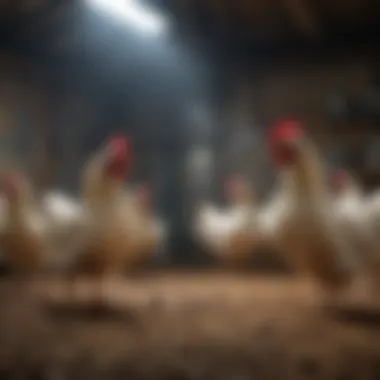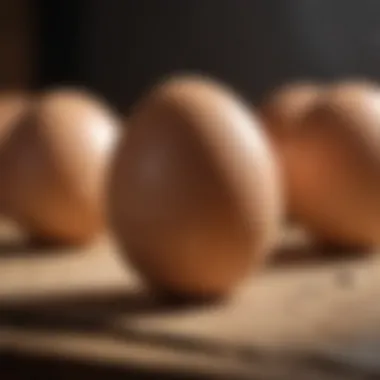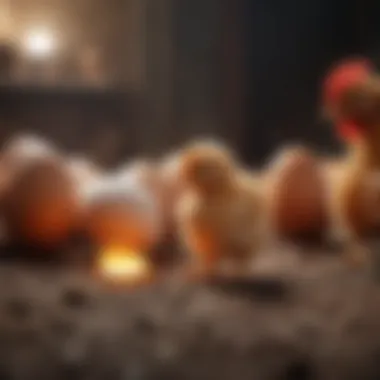Mastering the Art of Incubating Chickens: A Detailed Guide for Success


Animal Species Profile
Incubating chicken eggs is a fascinating task that requires patience and attention to detail. These avian marvels have been an essential part of human agriculture for centuries, providing not just meat and eggs but also a deep connection to the natural world.
Introduction to the animal species
Chicken, scientifically known as Gallus gallus domesticus, is a domesticated fowl breed primarily raised for its meat and eggs. These birds display a remarkable diversity in color, size, and behavior, making them a popular choice among farmers and hobbyists.
Physical characteristics and appearance
Chickens come in various breeds, each with distinct physical characteristics such as comb type, feather color, and body size. From the majestic plumage of the Silkie breed to the robust stature of Rhode Island Reds, chickens exhibit a wide range of appearances.
Natural habitat and distribution
Originally descended from the wild Red Junglefowl of Southeast Asia, chickens have adapted to diverse habitats worldwide. They thrive in farmyards, free-range settings, and even urban environments, showcasing their resilience and versatility.
Behavior and social interactions
Despite their reputation for being flock animals, chickens exhibit complex social behaviors. From establishing pecking orders to communicating through a variety of sounds and movements, these birds engage in intricate social dynamics within their groups.
Introduction to Incubating Chickens
Incubating chicken eggs is a meticulous process that plays a pivotal role in poultry farming. This comprehensive guide delves into every aspect of the incubation journey, from selecting fertile eggs to ensuring successful hatching. For both novice enthusiasts and seasoned farmers, understanding the intricacies of incubation is crucial for maximizing productivity and ensuring the well-being of the chicks. The careful management of temperature, humidity, and turning of eggs are fundamental practices that can significantly impact the success of the incubation process, making this guide an indispensable resource for anyone venturing into the realm of chicken incubation.
Understanding the Basics of Incubation
The Importance of Incubation for Chickens
The essence of incubation lies in facilitating the natural development of chicken embryos outside of a broody hen. This methodical process ensures that the eggs receive consistent warmth and humidity, replicating the conditions necessary for embryonic growth. The precise temperature regulation and conducive environment created by artificial incubation contribute to higher hatch rates and healthier chicks. One notable advantage of artificial incubation is its ability to scale up operations and provide more control over the incubation parameters, leading to more predictable outcomes in contrast to natural incubation methods.
Natural vs. Artificial Incubation Missthode


Natural incubation, which involves a broody hen sitting on the eggs to maintain the required warmth and humidity levels, is a time-tested method that mimics the birds' natural behavior. In contrast, artificial incubation utilizes advanced technology to regulate temperature and humidity accurately throughout the incubation period. While natural incubation may be preferred by some for its simplicity and natural approach, artificial incubation offers greater precision and consistency in controlling various factors critical for successful incubation, such as the missima temperature and humidity levels needed for optimal egg development.
Selecting Fertile Eggs
Identifying Healthy and Viable Eggs体
The foundation of a successful hatch begins with selecting healthy and fertile eggs. Identifying eggs with intact shells, without cracks or abnormalities, is essential, as damaged eggs may not develop properly or could introduce pathogens into the incubator. Additionally, choosing eggs from robust and disease-free hens increases the chances of producing strong and viable chicks. Understanding the characteristics of fertile eggs, such as size, shape, and freshness, enables breeders to make informed decisions when sourcing eggs for incubation, ultimately impacting the overall hatch rates and chick quality.
Proper Egg Storage Before Incubation
Proper egg storage prior to incubation is crucial for maintaining egg quality and viability. Storing eggs in a clean and cool environment, around 55 to 65 degrees Fahrenheit, helps preserve the integrity of the eggs before they enter the incubator. Avoiding extreme temperatures and fluctuations during storage is crucial, as it can adversely affect the embryo development inside the egg. By following recommended storage practices and turning the eggs regularly to prevent the yolks from sticking to the membranes, breeders can optimize hatchability and ensure a higher success rate during incubation.
Preparing the Incubator
Cleaning and Disinfecting the Incubator
Before commencing the incubation process, thorough cleaning and disinfection of the incubator are imperative to create a hygienic environment for the developing embryos. Removing any residues or contaminants from previous hatches minimizes the risk of bacterial contamination and ensures the health and well-being of the growing chicks. Regularly sterilizing the incubator with recommended disinfectants and maintaining cleanliness throughout the incubation period are essential practices to prevent potential health issues and promote optimal hatch rates.
Setting Up Temperature and Humidity Controls
Maintaining precise temperature and humidity levels within the incubator is critical for the successful development of the embryos. Setting the temperature between 99 to 100 degrees Fahrenheit and humidity levels around 50% to 60% creates an ideal environment for embryo growth. Consistently monitoring and adjusting these parameters according to the specific requirements of the developing embryos is vital for maximizing hatch rates and ensuring the health and vitality of the hatching chicks. By calibrating the temperature and humidity controls accurately, breeders can create a nurturing environment that mimics the conditions under a broody hen, fostering healthy chick development.
Monitoring Incubation Conditions
In the realm of incubating chicken eggs, monitoring incubation conditions serves as a pivotal task critical to the success of the incubation process. It involves meticulous oversight of temperature, humidity, and other environmental factors that directly impact the development of the embryos within the eggs. By vigilantly monitoring these conditions, hatchers can ensure optimal hatching rates and the health of the developing chicks. Understanding the fluctuations and nuances in these conditions allows incubators to make timely adjustments and intervene when necessary, safeguarding the well-being of the embryos.
Maintaining Optimal Temperature
Maintaining an optimal temperature within the incubator is paramount for the viability of the developing chick embryos. Temperature plays a fundamental role in the incubation process, influencing the rate of embryo development and ultimately determining the hatchability of the eggs. The precise temperature requirements for successful incubation typically range between 99 and 101 degrees Fahrenheit, with even slight deviations potentially leading to detrimental effects on embryo development and hatch rates. Therefore, constant vigilance and regulation of the temperature settings are essential to create a conducive environment for embryonic growth and maximize hatching success.
Adjusting Temperature Settings as Needed
The ability to adjust temperature settings according to the changing needs of the developing embryos is a crucial aspect of successful egg incubation. Variations in ambient temperature, egg size, and embryo stage can necessitate regular modifications to the incubator's settings to maintain the desired thermal conditions. By promptly responding to fluctuations and fine-tuning the temperature settings, hatchers can mitigate risks of developmental abnormalities and improve overall hatch rates. This adaptive approach ensures that the embryos receive the optimal thermal environment throughout incubation, fostering healthy growth and enhancing the chances of successful hatching.


Regulating Humidity Levels
Regulating humidity levels is another vital component of incubating chicken eggs, as it directly impacts egg water loss and embryo development. The relative humidity within the incubator plays a key role in preventing excessive evaporation from the eggs, which could lead to dehydration and compromised hatchability. Maintaining the ideal humidity level, typically between 45% and 55% relative humidity during most of the incubation period, is crucial for ensuring proper air cell formation and embryo growth. By understanding the significance of humidity in egg development and employing appropriate methods to adjust humidity levels as needed, hatchers can create an optimal incubation environment that supports healthy chick development.
The Role of Humidity in Egg Development
The role of humidity in egg development revolves around its influence on water loss from the eggs and the formation of the air cell, a crucial indicator of embryo development. Adequate humidity levels prevent excessive dehydration of the eggs, maintaining the necessary moisture content for proper chick formation. The optimal humidity range fosters uniform embryo growth, reduces malformations, and improves hatch rates, underscoring its importance in successful incubation practices.
Methods to Increase or Decrease Humidity
Various methods can be employed to adjust humidity levels within the incubator, depending on whether humidity needs to be increased or decreased. Techniques such as adding water trays, adjusting ventilation settings, or using wet sponges can effectively augment humidity levels, while increasing ventilation or using a dehumidifier can help reduce humidity when necessary. Adapting these methods based on regular humidity monitoring enables hatchers to maintain the desired humidity range throughout the incubation period, promoting optimal conditions for embryonic development and hatchability.
Importance of Egg Turning
The practice of regularly turning eggs during incubation plays a critical role in ensuring uniform embryonic growth and maximizing hatch rates. Egg turning prevents the embryos from adhering to the inner shell membrane, facilitating proper development of the chick and reducing the risk of deformities. Additionally, it promotes the circulation of nutrients and oxygen within the egg, contributing to overall embryo health and vitality.
Frequency and Techniques for Egg Turning
Determining the frequency and techniques for egg turning is a delicate balancing act that influences embryo positioning and development. Typically, eggs should be turned an odd number of times per day to prevent prolonged exposure of the embryo to the same position. Gentle rolling or tilting of the eggs at consistent intervals ensures that each part of the developing embryo receives adequate nutrient supply and oxygen, promoting even growth and minimizing the likelihood of malformations.
Impact of Turning on Chick Embryo Development
The impact of turning on chick embryo development is profound, affecting crucial processes such as blood vessel formation, musculoskeletal development, and overall health. Proper egg turning facilitates the distribution of nutrients and waste throughout the egg, preventing localized accumulation of metabolic byproducts that can impede development. Furthermore, it promotes the strengthening of embryonic muscles and bones, culminating in robust chicks that are better equipped for hatching and postnatal survival.
This meticulous attention to detail and proactive intervention in the incubation process underscore the significance of monitoring incubation conditions, maintaining optimal temperature and humidity levels, and implementing effective egg turning practices to achieve successful hatching outcomes. By heeding these guidelines and understanding the intricacies of incubating chicken eggs, hatchers can enhance their skills, boost hatch rates, and nurture healthy generations of poultry.
Optimizing Hatching Success
Optimizing Hatching Success is a critical phase in the incubation process, ensuring the best possible outcome for hatching. This section delves deep into the methods and techniques that enhance the success rate of hatching chicken eggs. Understanding the significance of factors such as proper temperature, humidity levels, and egg turning is paramount in achieving optimal hatching success. By meticulously following the recommendations in this guide, readers can maximize the chances of successful hatching, whether they are beginners or seasoned poultry keepers.
Candling Eggs for Viability
Understanding Cancdling Process


Candling eggs is an indispensable practice that aids in evaluating the viability of embryos within the eggs. This section sheds light on the process of candling, which involves passing a bright light through the egg to illuminate its contents. By observing the development stages, potential issues or irregularities can be identified early on, allowing for necessary adjustments to be made to optimize hatching success. The transparency provided by candling is invaluable in assessing the health and progress of the embryos, making it a popular and effective technique in egg incubation.
Interpreting Cancdling Results
Interpreting candling results plays a crucial role in determining the health and viability of the embryos. This segment elaborates on how to analyze the candling outcomes accurately, understanding signs of development, such as blood vessels and embryo movement. By interpreting the candling results correctly, individuals can make informed decisions regarding the eggs' progress and viability. This meticulous evaluation is instrumental in ensuring that only healthy and viable eggs continue the incubation process, ultimately contributing to successful hatching outcomes.
Preparing for Hatching
Creating a Safe and Warm Hatching Environment
Creating a safe and warm hatching environment is paramount for the unhindered development of the embryos. This part emphasizes the importance of providing a conducive setting for the eggs to hatch successfully. Maintaining optimal temperature and humidity levels, along with ensuring a clean and secure environment, creates an ideal space for the chicks to emerge healthy and strong. The careful preparation of the hatching environment significantly impacts the overall hatching success rate, making it a pivotal aspect of the incubation process.
Signs of Imminent Hatching
Recognizing the signs indicating imminent hatching is crucial for preparatory measures. This section elucidates the key indicators that signify the approaching hatching process, such as increased chirping from the chicks inside the eggs, visible pipping, or movement. Understanding these signs allows incubators to make necessary arrangements and adjustments to facilitate a smooth hatching process. By being attentive to these signals, individuals can ensure a seamless transition from incubation to hatching, contributing to favorable outcomes for both the chicks and the incubators.
Assisting in Hatching Process
When anf How ot Intervene During Hatching
Knowing when and how to intervene during the hatching process is essential to support chicks that may encounter difficulties. This section educates individuals on identifying when assistance is required, such as prolonged hatching duration or chicks struggling to hatch. By intervening strategically and gently, hatchers can aid chicks in successfully emerging from their shells, promoting their well-being and survival. Understanding the appropriate intervention methods ensures that chicks requiring assistance still have a chance for a healthy start.
Rescuing Stuck or Weak Chicks
Rescuing stuck or weak chicks is a delicate yet crucial aspect of the hatching process. This part delves into the methods and considerations for assisting chicks that are unable to hatch independently or exhibit signs of weakness. By providing timely and appropriate support, such as carefully removing shell fragments or offering supplementary warmth, hatchers can increase the chances of survival for these vulnerable chicks. This compassionate intervention is instrumental in nurturing the chicks towards a healthy and thriving future.
Conclusion
In delving deep into the intricacies of incubating chickens, the conclusion of this guide serves as a pivotal moment for both novice poultry enthusiasts and experienced farmers alike. Within the context of this article, the focus lies on the final steps towards ensuring successful incubation and transitioning from the controlled environment of the incubator to the broader realm of chick care. This section encapsulates the culmination of efforts, where the theoretical knowledge and practical applications converge to set the stage for the next phase of tending to the newly hatched chicks.
Final Steps Towards Successful Incubation
Preparing for Chick Care After Hatching
Discussing the preparation for chick care after hatching unveils a crucial aspect of the incubation process. As the incubated eggs hatch and the chicks emerge, the responsibility shifts from ensuring optimal conditions within the incubator to creating a nurturing environment for the newborns. This phase requires meticulous attention to detail, including setting up the brooding area with appropriate heat sources, bedding, and feed stations. Monitoring the chicks' behavior closely post-hatch is essential to ensure they adapt well to their new surroundings. The immediate care provided after hatching greatly influences the chicks' health and development, setting the tone for their growth journey.
Reflecting on Incubation Experience
Reflecting on the incubation experience offers a moment of introspection and evaluation for the individuals involved in the process. This critical review allows for an assessment of what worked effectively during the incubation period, what challenges were encountered, and how improvements can be made for future incubation cycles. Understanding the incubation experience not only facilitates continuous learning and enhancement but also nurtures a deeper connection to the poultry rearing process. It enables practitioners to refine their strategies, troubleshoot any issues encountered, and adapt their approaches to achieve better hatching outcomes moving forward. Learning from each incubation experience contributes to the accumulation of valuable insights and expertise in the realm of poultry incubation.







